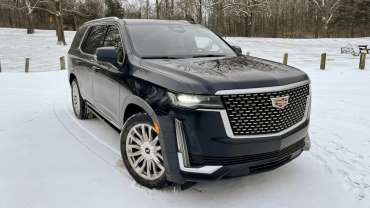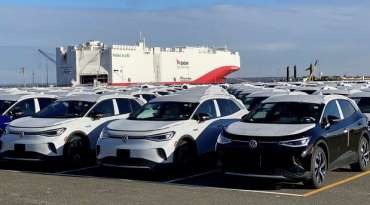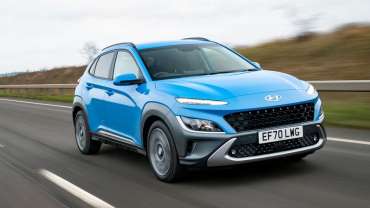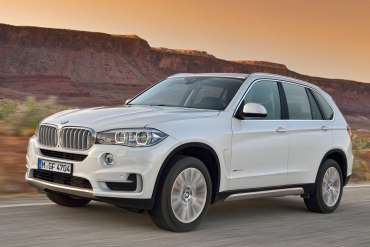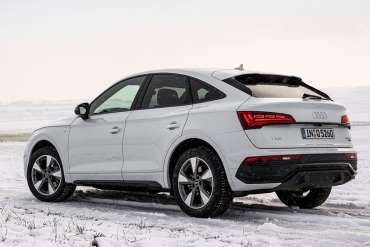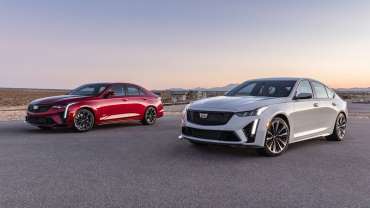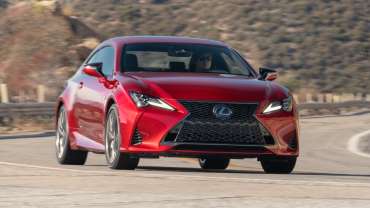
Worldcarblog.com
2021 Cadillac Escalade Diesel First Drive Review: The Power of Choice
Gasoline or diesel? In the new Escalade, there’s no wrong way to go.
Here's the good news for full-size luxury SUV buyers: Not only does the 2021 Cadillac Escalade diesel drive nearly identically to the excellent, gasoline-chugging model, it also costs the exact same amount, is just as impressive inside, and gets notably better fuel economy. The bad news? Well, there isn't any, unless you're a hardcore V-8 partisan.
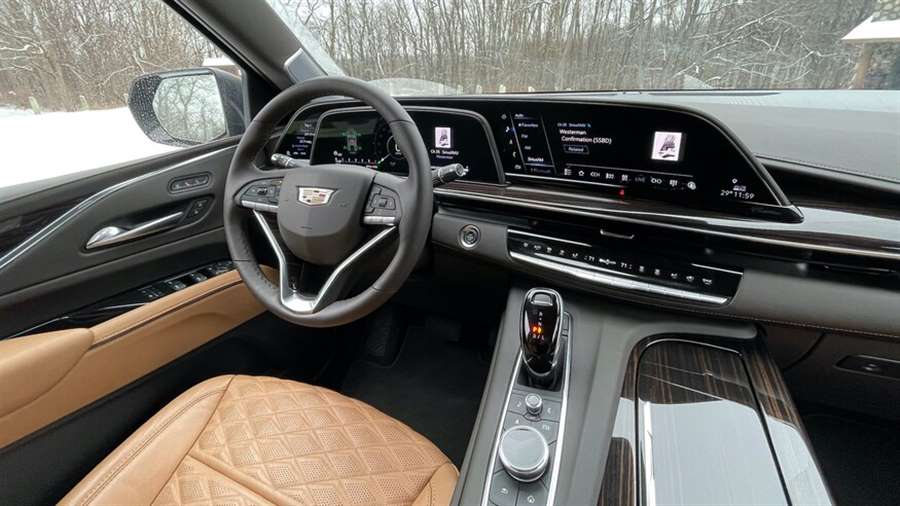
Added as part of the Escalade's wholesale redesign for 2021, the diesel version lacks the gasoline model's ferocious growl under full-bore acceleration, as well as its mid-range and top-end muscle during freeway-speed passing maneuvers. But the diesel delivers in virtually all other circumstances. In terms of output, here's how they stack up: The gas V-8 churns out 420 horsepower and 460 lb-ft of torque, while the Duramax inline six-cylinder turbodiesel is rated for 277 hp and an equal 460 lb-ft.
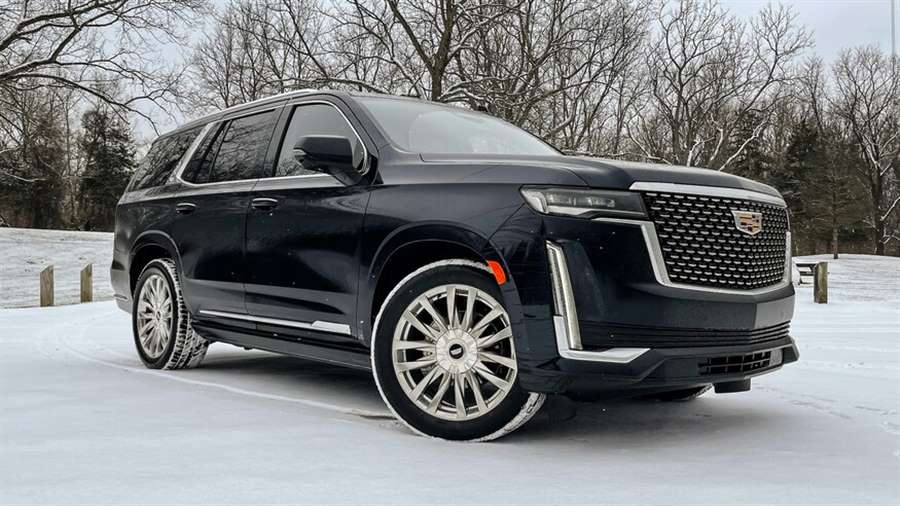
Striking Similarities
After punching the diesel's ignition button, the first thing we noticed was the massive, bladder-busting 560 miles of range indicated in the gorgeous OLED digital instrument panel—note we didn't say "diesel clatter." Sure, anyone attuned to diesels will be able to pick up the telltale cues, but the smooth Duramax is quiet and refined enough to go undetected by most. Under acceleration, it's a bit gruffer in tone than the V-8, but those who have owned or spent time in European diesel SUVs from, say, Audi or Mercedes won't bat an eye.
The 2021 Cadillac Escalade diesel, which is visually separated only by the "600D" badge on its liftgate and a lower redline on its digital tachometer, pulls away smartly from a stop, its 10-speed automatic shuffling through gear ratios completely invisibly. We recently tested the mechanically similar but longer-wheelbase Chevy Suburban with this same diesel engine, and it chuffed its way to 60 mph in 8.5 seconds; figure this Escalade to register a time in the same neighborhood given comparable curb weights. The Caddy isn't a scorcher, but neither does it ever feel slow.
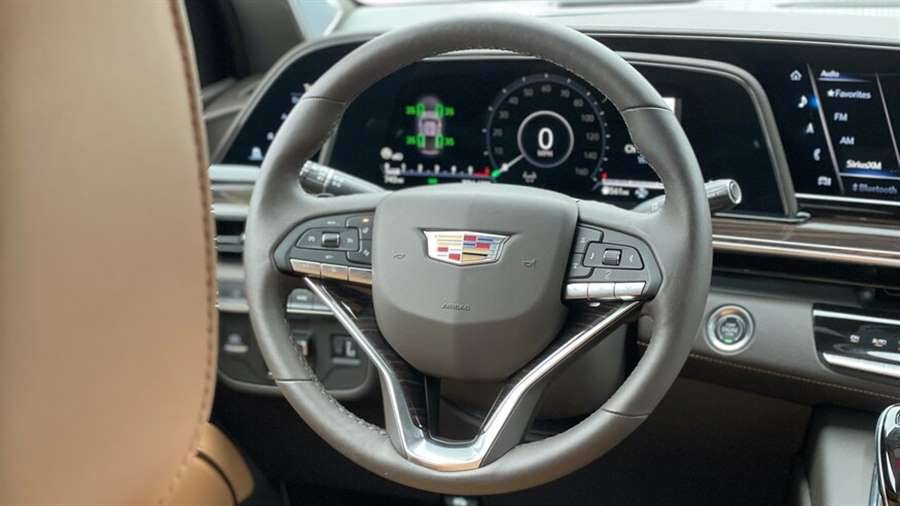
How The Diesel Drives
The new Escalade's refined and fine-driving chassis is here, too, with linear and accurate steering that allows easy placement in parking lots and on freeways, back roads, and everywhere in between. The suspension on our example had the optional magnetorheological dampers, and it rode as smooth as you can reasonably expect given the Escalade's body-on-frame construction, ginormous 22-inch wheels, and the atrocious quality of Michigan roads we tested it on. They remain devoid of feel regardless of engine, but the brakes are predictable and well up to the task of slowing down such a hefty boy, though we have yet to test their efficacy with a trailer strapped to the back of the Caddy.
The maximum tow ratings are basically aligned between diesel and gas Escalades—sensing a theme yet?—with the diesel rated to pull 7,800 pounds with four-wheel drive and 8,000 pounds with rear-wheel drive. Those numbers are 200 pounds shy of the V-8's due to the overall mass differences between the powertrains; the diesel is about 190 pounds heavier than the V-8 when accounting for all accessories, such as the diesel exhaust-treatment system. Even so, frequent luggers may want to opt for the Duramax, whose maximum torque is available at just 1,500 rpm versus the 6.2-liter's 4,100 rpm.
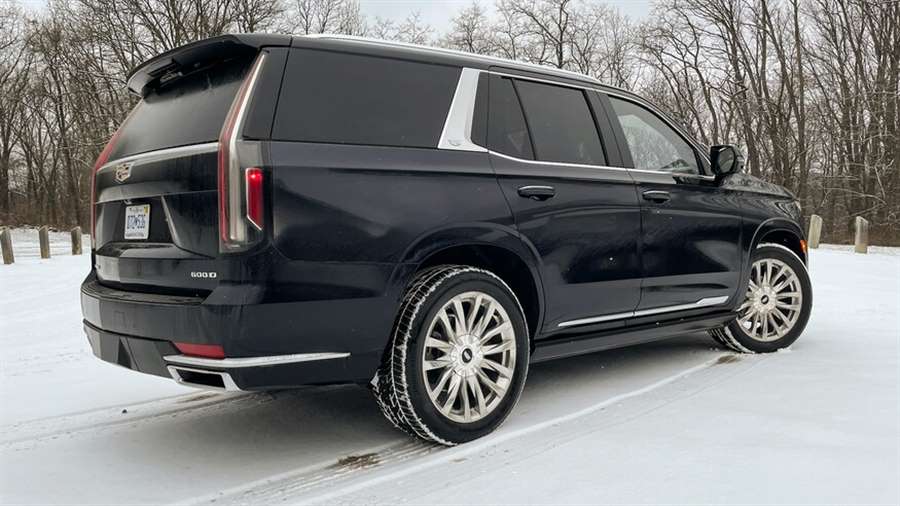
Everything That's Great About The Escalade
Like other 2021 Escalades, the diesel model is stuffed with hugely luxurious and technology-rich innards. There's the trio of highly impressive OLED screens placed in front of the driver, with a touch-sensitive trip and driver's info readout to the left of the steering wheel, a configurable instrument panel, and a sweeping central infotainment touchscreen. The software is quick to respond and gorgeously rendered, and we love the fact automakers are starting to install screens in shapes that complement a vehicle's interior aesthetic. The Escalade's approach mitigates what could be an overwhelming digital experience.
Instead, the experience is rich, the decadent cabin slathered with wood, metal accents, and supple leather upholstery. This particular diesel Escalade was delivered with the $2,000 Brandy and Very Dark Atmosphere interior option—that's caramel brown and dark gray for those who don't speak "pretentious"—that also adds stylish diamond stitching to the seats. There are a number of interior colors available, with a plethora of additional options for wood trim, stitch patterns, and more. The available $1,995 rear-entertainment system features large, high-resolution screens and tons of connectivity options, and we'd consider it a must if you anticipate frequently shuttling passengers. There were a few minor missteps—one or two wavy stitches/bits of piping, some parts-bin switchgear—but the 2021 Cadillac Escalade's cabin is quiet and comfortable, with the design and execution you'd expect to find in a six-figure vehicle.
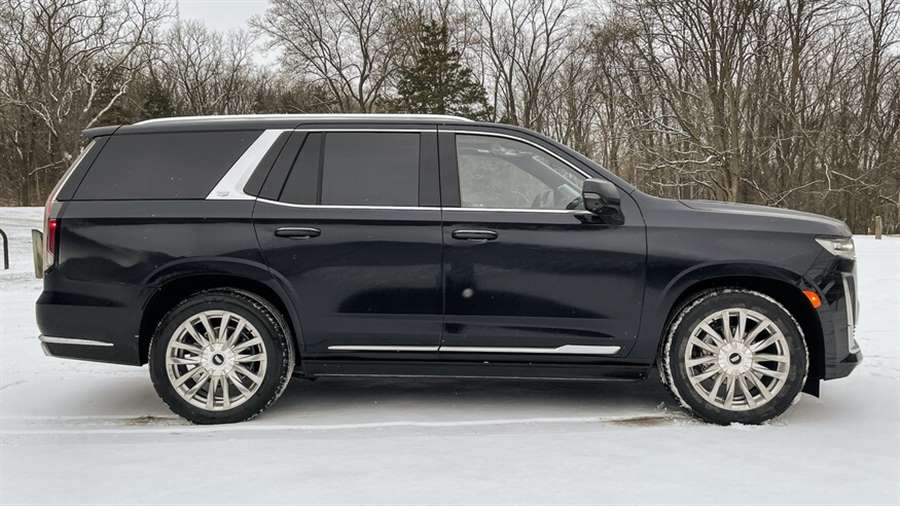
The Cost Of Excellence
And that's where the diesel-powered, short-wheelbase Premium Luxury 4WD model we drove landed: $104,910, with $17,620 worth of options factored in. We won't get into the value proposition of adding $1,750 in power-retracting side steps or the amazing-sounding $4,300 AKG audio system or any of the other goodies; if you're shopping for an Escalade, cost probably isn't a problem. That also means the financial implications of the Escalade diesel's fuel economy don't matter, either. But it's still nice that the Duramax returns 21 mpg city and 27 mpg highway with rear-drive, or 20/26 with four-wheel drive; those are up from 15/20 and 14/19 in the V-8 model.
Choosing which 2021 Cadillac Escalade engine is right for you is as much about what you plan to do with it than anything else. Tow or hit the highway a lot? Diesel. Strike a showy stance best augmented by the chest-thumping rumble of a V-8? Gasoline. Based on this initial experience, though, it's clear that whatever your choice, it won't be a wrong one.
Source: motortrend.com
Volkswagen wants to sell over 100,000 electric ID.4s in 2021
The first contingent of the ID.4 crossover set off on its way to its future owners in Europe, China and the United States.
The Volkswagen ID.4 is the second production model of the new generation of electric vehicles manufactured by Wolfsburg, after the ID.3 that broke the ice last year. Both cars are based on the MEB mechanical platform developed by VW specifically for electric vehicles.
According to B92, optimistic forecasts are coming from the German manufacturer that it should deliver over 100,000 copies of the ID.4 crossover to customers this year alone, although they have received only about 17,000 orders so far. The VW ID.4 is currently being produced at the Zwickau plant in Germany, as well as in China, and will soon start production in Emden (Germany) and, next year, in the Chattanooga factory (USA).
New Hyundai Kona 2021 review
The Hyundai Kona has been revised for 2021 and we find out just how much it's improved
The updates to the Hyundai Kona improve its overall experience, with an efficient and effective mild-hybrid powertrain, a more composed and comfortable ride, and some useful tech upgrades in the cabin. But these gains aren’t enough to shove the car to the front of the pack; the Kona still isn’t as good to drive as the best small SUVs, and it continues to lag behind the likes of the Renault Captur and Ford Puma on practicality.
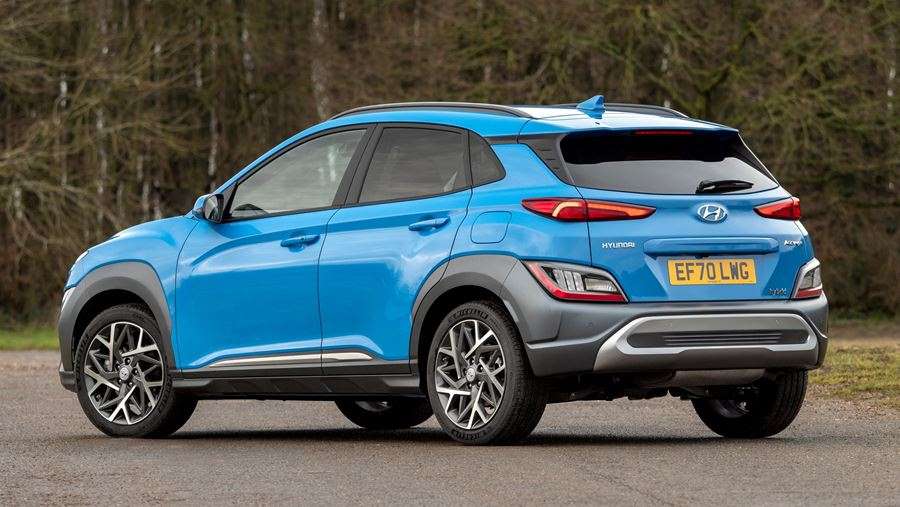
Hyundai will soon have an embarrassment of riches in the small SUV class. The Korean brand has a new offering, the Bayon, on the way in the coming months. And it will be joining a facelifted version of the Kona in the line-up.
Here, then, is the revised version of Hyundai’s ‘original’ small SUV. It’s had a little more than the typical mid-life nip and tuck too; yes, the usual updates like headlights and bumpers are present and correct, but there’s also a redesigned bonnet, and the changes are sufficient to make this car around 40mm longer overall than the outgoing version. The overall effect is to give the car a slightly more aggressive, chunky stance - perhaps even making it more of a crossover and less of a baby SUV. There’s also a new N Line trim level that tries to add a sporty look.
Under the bonnet, the Kona gets an updated range of engines. The 1.6-litre turbo unit at the top of the line-up gains some extra power, moving up to 195bhp, and the diesel motor (yes, here’s a car still available with one) gains a 48-volt mild-hybrid system.
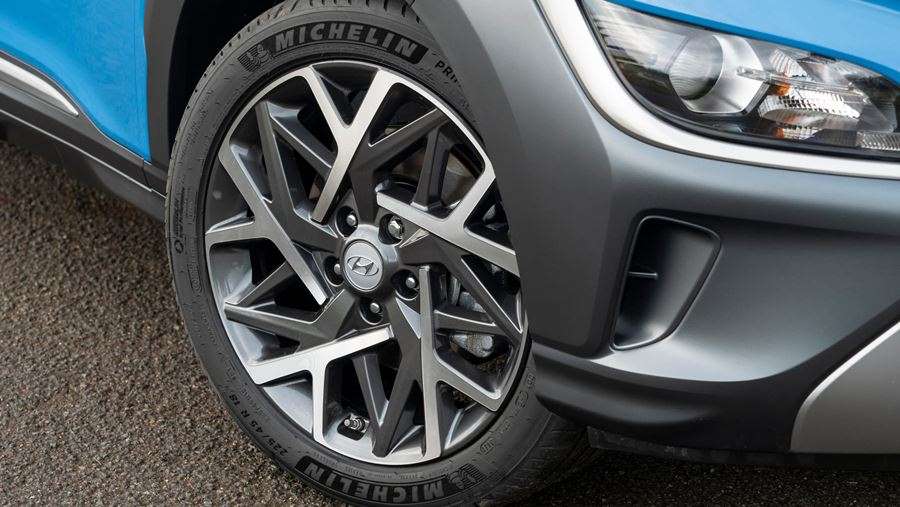
The same tech is also available as an option on the Kona’s 1.0-litre, three-cylinder turbocharged petrol engine - and it’s this powertrain that we’re driving here. The engine itself produces 118bhp, and is the same unit that is likely to appear in higher-end i20s later this year.
The hybrid system uses an integrated starter/generator and a small lithium-ion battery to give the combustion engine a boost when pulling away from rest. It also benefits, though, from Hyundai’s Intelligent Manual Transmission - a six-speed manual gearbox that has no physical connection between the clutch pedal and the clutch. This sensor-based solution means that the engine can be switched off when the car is cruising along - and then fired up again, thanks to the 48-volt hybrid tech, when required.
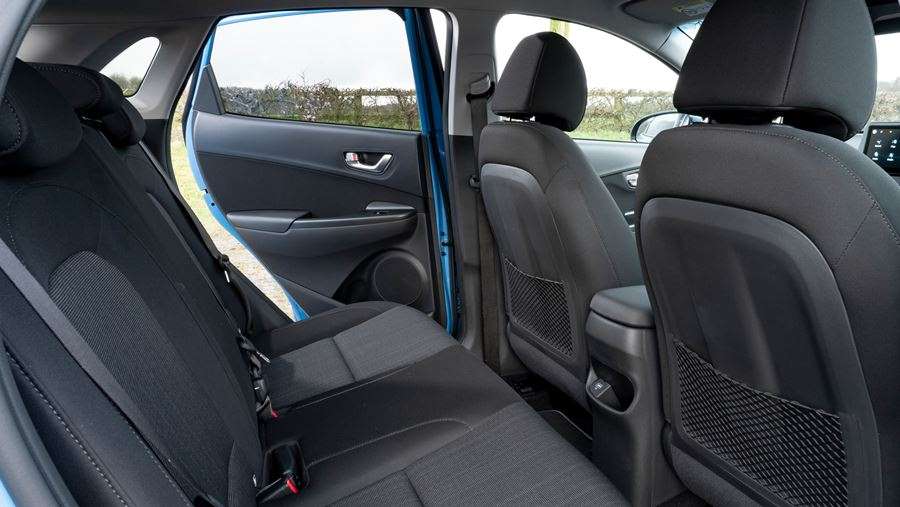
It’s a complex piece of engineering but in practice works extremely well. You won’t feel much extra shove when starting off but once you’re up and running, you’ll have to rely on the visual cues on the instrument panel - the rev-counter needle flicking up and down - to tell that the engine is being cut in and out. It’s incredibly smooth in its transition - astonishingly so when you think that you can be doing 70mph at the time.
The engine has enough power to cope with a car of the Kona’s size, but not quite enough to ever make it feel like it’s capable of really punchy performance. The 0-62mph dash takes a leisurely 11.9 seconds - making the electrified version of this engine slower than the non-hybrid edition in either manual or auto form. It’s more efficient, though, with claimed average economy of 46.3mpg, and based on our experience with the car, this should be achievable in everyday use.
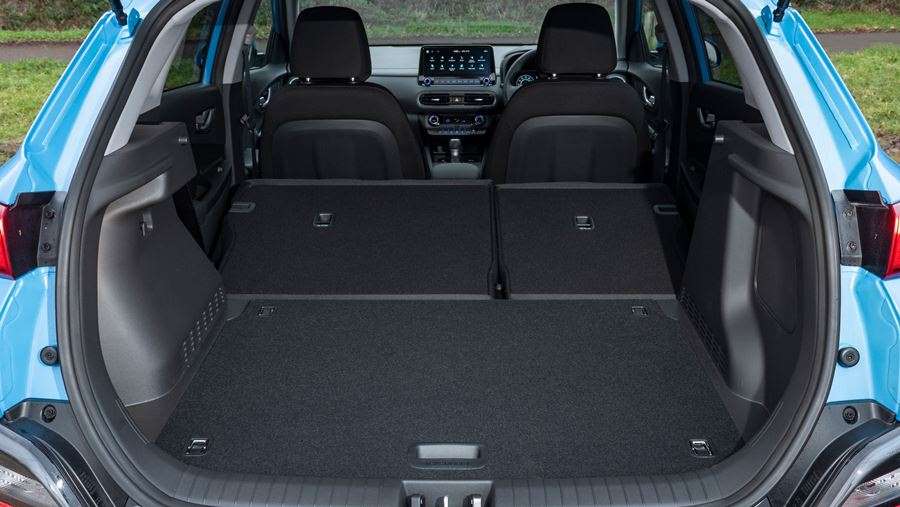
The Kona has also received tweaks to its chassis and suspension, and while they’re not enough to transform the car into a vehicle with real appeal for keen drivers, they do give the model a bit more dynamic polish. The most pleasing development of all is better bump absorption, making the Kona an effective tool on scarred urban roads, even on our Ultimate model’s 18-inch alloy wheels.
Body control feels a little tighter than before too, so while the inert steering and taller body still don’t really play ball and deliver enjoyment on twisty roads, the overall package feels like a more effective compromise than it did before. It’s a result, we’d like to think, of the UK testing instigated by Hyundai’s head of vehicle dynamics, ex-BMW M division man Albert Biermann.
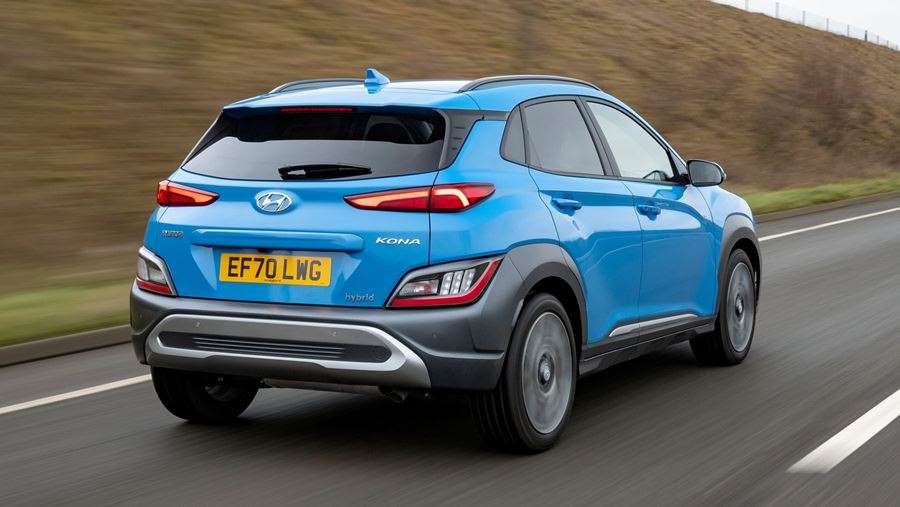
In the cabin the biggest upgrade comes in tech, thanks to a new 10.25-inch digital instrument cluster, as seen first in the all-new i20. It’s crisp and easy to use - an ideal companion, in fact, for the similarly sized infotainment system that comes as standard on this Ultimate trim level. It remains one of the best set-ups you’ll find in any vehicle, frankly, with clear graphics, a great interface and quick responses to inputs. Recent upgrades have improved its connectivity further, thanks to fresh functionality in Hyundai’s Bluelink phone application.
The rest of the cabin gets some new materials but they don’t do much to lift the overall experience. It’s not that it’s badly screwed together or lacking soft-touch fabrics in key areas; it’s just that the fascia is a sea of black, grey and dark grey plastic, with only the very occasional flash of chrome to brighten proceedings.
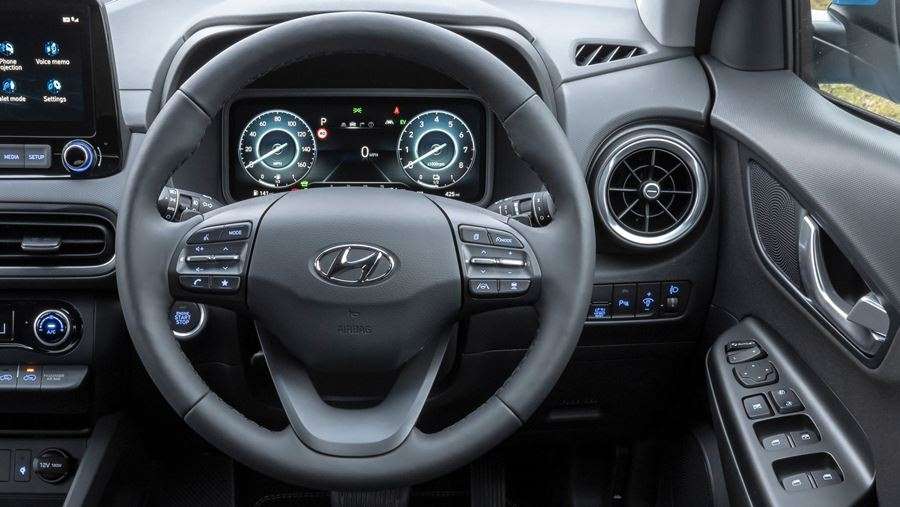
Nor, it must be said, has the facelift done anything to address one of the Kona’s key weaknesses: rear packaging. Two adults can fit in there, even behind a couple of six-footers, but once in place, they’re unlikely to thank you for anything approaching a long journey.
The boot remains pretty unimpressive too - not helped, still, by a relatively high floor that’s designed to accommodate the circuitry of the hybrid and pure-electric editions. The Kona’s capacity is 374 litres, so it isn’t going to challenge the Renault Captur, Peugeot 2008 or Ford Puma on practicality.
Source: autoexpress.co.uk
What is the actual fuel consumption at maximum speeds?
When the driver has a heavy foot, the fuel sellers rub their hands contentedly. Fuel consumption in cars running on highways at full throttle is dizzying.
To reduce fuel consumption, car manufacturers use various tricks like downsizing, reducing the number of cylinders, using lighter materials. Basically, all this brings the expected results. For example, diesel engines are increasingly consuming almost 4 l / 100 km. However, it should be noted that the lowest consumption is achieved in ideal conditions, where none of the tested cars accelerated over 120 km / h.
However, in practice it is completely different. The more often you press the accelerator pedal to the floor, the higher the fuel consumption. So, all the manufacturer's data goes to the sky, even if the car is driven at the allowed speed. Cars have to fight air resistance and rolling. Vehicle weight also plays a big role.
It’s good to remember that the faster you drive, the higher the air resistance. This is important because the maximum values of power and speed increase with each new model. Today, in compact engines with a mediocre engine, you can easily drive 200 km / h.
AutoBild reporters selected 10 cars that they chased with the left lane of a German highway with the right pedal pressed to the floor. See below how greedy the tested cars were.
Mercedes G 500
Mercedes has created a real monster. The G 500 is equipped with a powerful 387 hp engine and 530 Nm of torque. Under full throttle, it consumed 62.3 liters per 100 kilometers
BMW M5
The result achieved in the BMW M5 is 62 l / 100 km
Audi A8
The trip computer reports that the fuel consumption is 32.9 l / 100 km. But don't trust him. In fact, the Audi A8 consumes 36.6 l / 100 km
BMW X5
If the driver has a heavy leg, the X5 50i will consume more than 49 liters of fuel per 100 km on the motorway
Fiat Ducato
With the gas pressed to the floor, the Ducato consumes 17.9 l / 100 km
Jaguar XFR-S
If you were to drive at top speed all the time, the fuel in Jaguar’s tank would only last 112 kilometers. The Jaguar XFR-S consumes 62.5 liters of gasoline per 100 km at top speed
Golf 7
The VW Golf 2.0 TDI consumed over 14.5 l / 100 km of diesel while driving at full throttle.
Mazda 3
The two-liter, four-cylinder Mazda 3 engine burns 22.2 liters of gasoline in the exhaust after 100 km
Škoda Octavia 1.2 TSI
The 105 hp Škoda Octavia 1.2 TSI consumed 13.4 l / 100 km in the test
If you really want to save fuel, take your foot off the accelerator pedal. Without this, no technical trick used by car manufacturers will help reduce fuel consumption.
Audi Q5 Sportback review
Audi has expanded the popular Q5 SUV range with a slightly sportier-looking, low-roofed variant. Predictable this model may be – but with good reason, as the less-bulky profile appeals to buyers previously reluctant to go for the boxy bulk of a traditional SUV
Taking cues from the succesful A5 Sportback, the Q5 Sportback joins the Q3 Sportback and electric-only e-Tron to give Audi customers a choice coupe-SUVs to complement their full-sized sister cars. It's a sensible recipe, too, taking the five-door practicality of the A5 Sportback and adding ground clearance and Quattro all-wheel drive on all but the least powerful model. It takes on the established Mercedes-Benz GLC Coupe, among other less direct competitors.
Just a few centimetres longer than the regular, boxy Q5, the Sportback retains ample room for five with just a small reduction in headroom. A new, optional seating system – rear seat bench plus – introduces a sliding bench and multi-position reclining backrest.
What's new about the Audi Q5 Sportback?
Although much of the Q5 Sportback's engineering and technology is shared with the regular Q5, no-one buys a sporty-looking SUV like this hoping they won't be noticed. Audi's drawing attention to the new model with a new lighting technology, OLED rear lights.
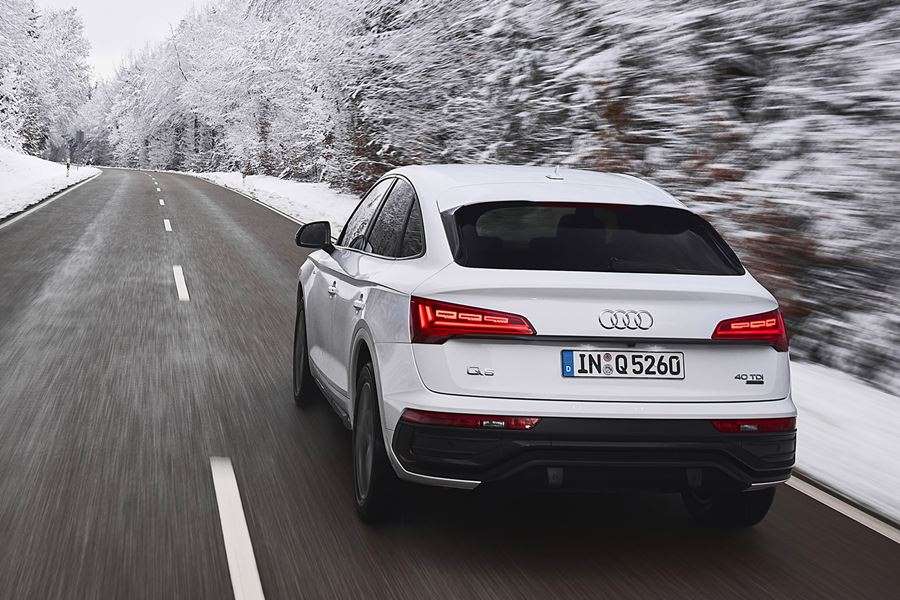
These multi-segment units don't just use a bright, low-power technology (the same technology you'll find in high-end smartphone screens) for shattering the darkness. Different patterns and configurations are possible, with a safety system ensuring your driving-mode signature becomes a full set of illumination as cars approach from behind.
If you thought dynamic indicators had helped Audi stand out on Britain's motorways, this new animated tail-light tech should really grab you. Even without the fancy showcase, OLED lighting is more consistent and even, ensuring that light signature is clear from every angle.
What's under the skin?
There are no surprises here - the Q5 Sportback offers a 2.0-litre diesel or 2.0-litre petrol (more details below). Both are four-cylinder units with 204hp available in the diesel. Diesel models make use of twin-dosing AdBlue selective catalytic reduction (SCR), which in other Volkswagen group cars and vans has proven very successful in reducing real-world NOx output.
Emissions will be further reduced with two plug-in hybrid models when they come on stream later. Care more about performance than your green credentials? There's a diesel-powered SQ5 Sportback too.
Sharing technology with the Q5 means a wide variety of options, including standard, adaptive and air suspension - the latter can raise the car by 45mm for dirt roads, and lowers it by 15mm for improved economy at speed. Steel springs are set up for a sportier feel than the standard Q5, further assisted by optional adaptive dampers and optional dynamic steering. Speaking of options, there are up to 21 different designs of wheel available, from 18- to 21-inches.
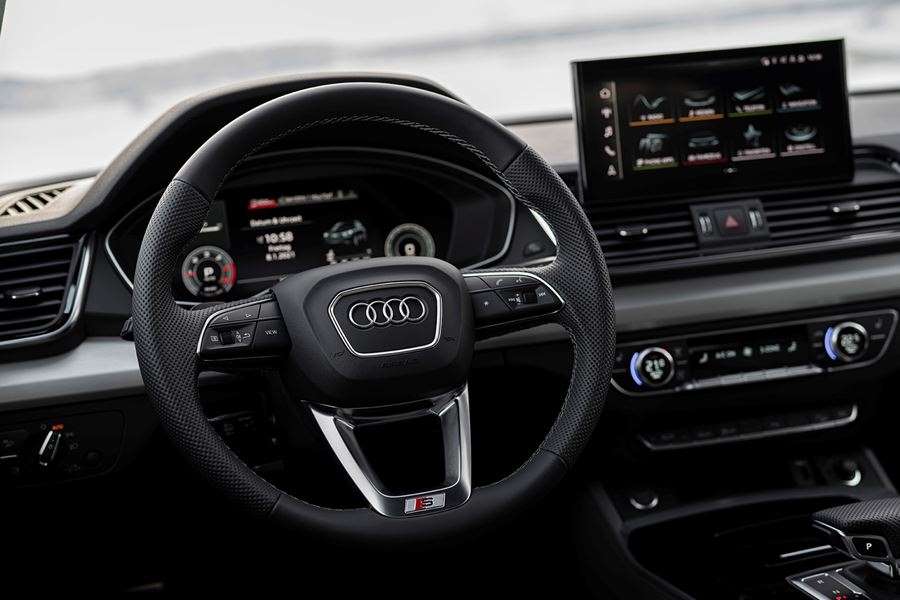
What's it like inside?
Audi's well-regarded MMI - MultiMedia Interface - has been revised and the Q5 Sportback benefits from the latest updates including an infotainment touchscreen with handwriting recognition, improved voice control and comprehensive steering controls.
Mounted in the centre of the dashboard, the main display is 10.1-inches. Ahead of the driver Audi's now-familiar 12.3-inch Virtual Cockpit benefits from the latest developments including hazard warning messages, information about obstructions in the road and traffic-flow awareness to help plan journeys with the least amount of interruptions.
The low-roofed Q5 Sportback is a roomy car and can carry 1,480 litres of cargo with the seats folded. With them raised, the luggage area is 510 litres – on models with the optional bench this can be increased to 570 litres at the expense of rear legroom.
What's it like to drive?
Unsuprisingly, the Q5 Sportback is very similar to drive to its Q5 Cousin. We sampled the range briefly in Germany and can report that it is a refined and effortless cruiser as you'd expect it to be. Sadly, it's not perfect – the V6-powered 50 TDI lacks response away from the lights, and despite e-boost from its mild-hybrid system, it's hesitant to take off, and in busy situations it can feel dreadfully sluggish.
The good news is that the 45 TFSI and 40TDI are not similarly affected. Also, regardless of which engine you choose, there is absolutely nothing wrong with the way these Sportback models handle and ride. On 19-inch wheels, it's stable and planted on the road with unwavering accuracy whatever the surface conditions. In low-grip conditions, the grip and poise is particularly impressive.
The most sporting SQ5 model is very impressive all round, with bags of performance. Despite weighing a portly 2085kg, it will sprint from 0-62mph in 5.1sec from 0-62mph and tops out at a limited 155mph. It's a mild hybrid that can regenerate up to 8kW under braking and will coast with the engine off for up to 40 seconds. Handling and ride are both excellent, too.
Buyers who venture off-road on a regular basis should consider the height-adjustable air suspension together with the side-to-side rear sport differential. Not surprisingly, the air springs also further cushion the ride, lower the body a tad at speed and have the rear end kneel down by 55mm to facilitate loading and unloading.
What models are available?
This is a diesel-centric line-up, at least initially. The model range starts with the 2.0-litre 204hp 40 TDI. Other diesel models will include the 163hp 35 TDI, the 285hp 3.0-litre V6 50 TDI and the mighty 355hp SQ5 Sportback.
There's also a 265hp 2.0-litre four-cylinder turbo petrol engine (the 45 TFSI) – but it will get more interesting (and tax efficient) once the two plug-in hybrids join the range later in 2021. All models have an automatic transmission system, regardless of whether they are front- or four-wheel drive.
Should you buy an Audi Q5 Sportback?
If you're a regular Audi Q5 buyer and fancy something sleeker, here's your next car. It's a class act, mechanically and in terms of fit and finish, but it's not perfect. Although it's a mild hybrid, it feels like a step behind its PHEV rivals and will look old-hat compared with the upcoming all-electric Q6 E-Tron.
We've yet to try it against its immediate rivals, the BMW X6 and Mercedes-Benz GLC Coupe, but the Audi's classy interior and wide range of petrol and diesel engines stand it in good stead – even if it's likely to lag behind the BMW for steering feel and handling.
It's another premium, sporty-looking SUV so you can sit high up, feel safe, and still have a car with more kerbside appeal than a large box on wheels. As it inherits technology and styling from the rest of the Audi A5/Q5 range, it's a known quantity both for reliability and comfort, and for making the right impact on your neightbours when you get it home.
It's more expensive than the car it's based upon and Audi feels its customers will be prepared to pay the premium. The Q5 Sportback is a safe buy, and one that will remain in demand new or used as the UK heads towards the ban on new petrol and diesel car sales, and the SQ5 Sportback is quite a sendoff just as the e-Trons start to take over...
Source: parkers.co.uk
Last goodbye to an era - Cadillac introduced the Blackwing edition of the CT4 and CT5 models
It was summer 2008 when Cadillac appeared with its latest CTS-V sedan on the famous German Nürburgring. With 556 horsepower under the hood, at the end of the day it managed to achieve a time of seven minutes and 59 seconds, which was faster than any serial BMW M5 sedan, Mercedes E63 AMG and Audi RS6 on the planet.
General Motors reminded why Cadillac has long been considered the "world standard" and hinted that it has not forgotten to produce high-performance sedans. Unfortunately, the successes of the sports models from the V family have never been transferred to the rest of the offer, so Cadillac today still lags behind the German competition, as well as Lexus, even in the domestic market.
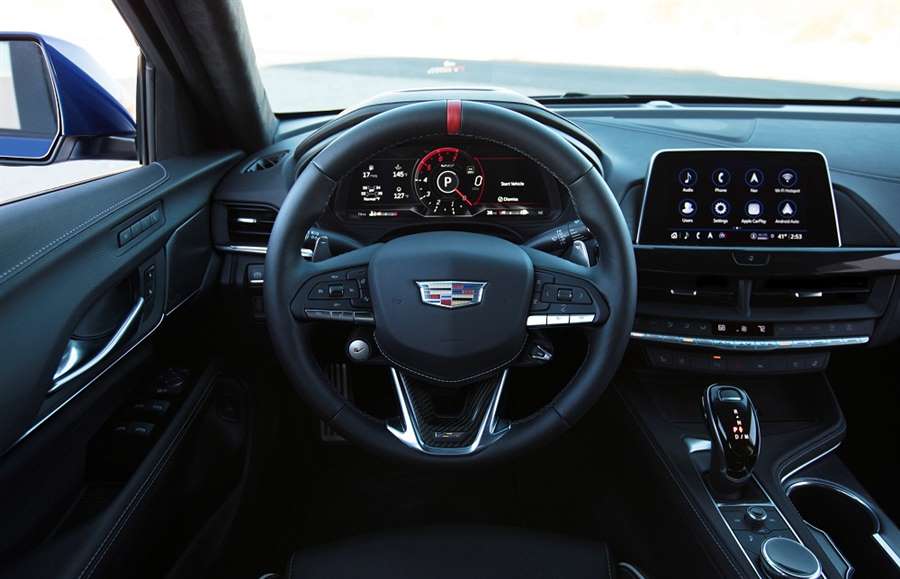
The largest American producer stated a few days ago that its entire offer "across the pond" will be on electricity until 2035. We don't know if Mary Barra really has such plans or maybe she's just "selling the fog" to cash in on her position for a more comfortable pension, but if that's true, we don't have much time left to enjoy high-performance models - at least not. in those using internal combustion engines.
As one last "big goodbye" to the truly fantastic Cadillacs designed by the performance Division V, the company has prepared special editions of the CT4 and CT5 models. But they are not only called "V", as was the case in the past, but Blackwing after the eponymous generation of engines.
The premiere arrived at Daytona’s most famous track where the famous Daytona 24 Hour Endurance Race was run over the weekend. The American team did not manage to win the competition, but they finished in a satisfactory second position after the tire of one of the runners burst, seven minutes before the end.
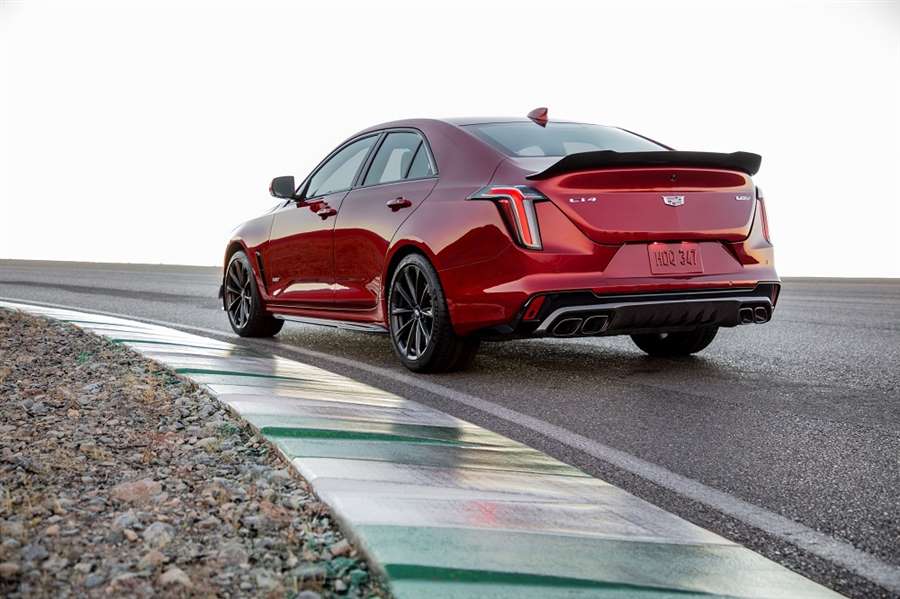
Cadillac told us that these last Cadillacs with SUS engines are high-power, and that in the future they will concentrate only on electric versions.
Let's go in order and let's first pay attention to the smaller CT4-V Blackwing. A replacement for the former much-lauded but poorly-sold ATS model, the CT4 has also not greatly charmed customers. Many will say that the popularity of the crossover is to blame for something like that, and that we can be satisfied that this sedan even exists, but at the end of the day, the ATS and CT4 really do not differ to the extent that Cadillac would like customers to think.
Both cars share an identical 3.6-liter turbo petrol with 472 horsepower and a maximum of 603 Nm of torque. The ATS and CT4 also share a six-speed manual transmission, but the optional ten-speed automatic provides two more gears than was the case before. Cadillac adds that Brembo brakes, 18-inch wheels with Michelin Pilot Sport 4S tires and many aluminum details have also been improved, thanks to which the weight has been reduced by about 30 kilograms. According to the factory data, the acceleration from standstill to 100 km / h occupies a time of 3.8 seconds, while the maximum speed is limited to 304 km / h.
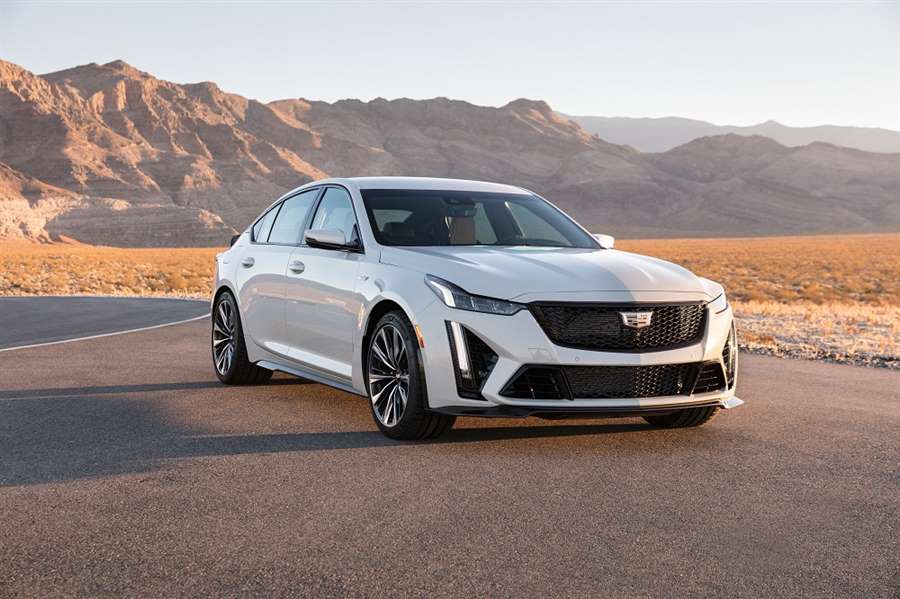
On the design side, the Blackwing does not differ much from the cheaper CT4-V. There are many aerodynamic accessories thanks to which the novelty will be extremely fun to drive on professional tracks, and at least on paper it seems like a sure winner compared to the competition. For example, the Audi RS3 boasts 394 horsepower and acceleration from standstill to 100 km / h in 3.9 seconds, while the Mercedes-AMG CLA45 is eight "horses" weaker and an additional 0.1 seconds slower. However, the CT4 Blackwing costs 59,990 US dollars, which is slightly more than the German competition, and at the end of the day, the rule "as much money as much music" applies.
No matter how impressive CT4 looks, the biggest attention during today in Detroit was drawn by his older brother CT5-V Blackwing. The successor to the legendary CTS, which we mentioned at the beginning of the Prile, now develops as much as 668 horsepower and is the most powerful engine that Cadillac premiered in its 118-year history.
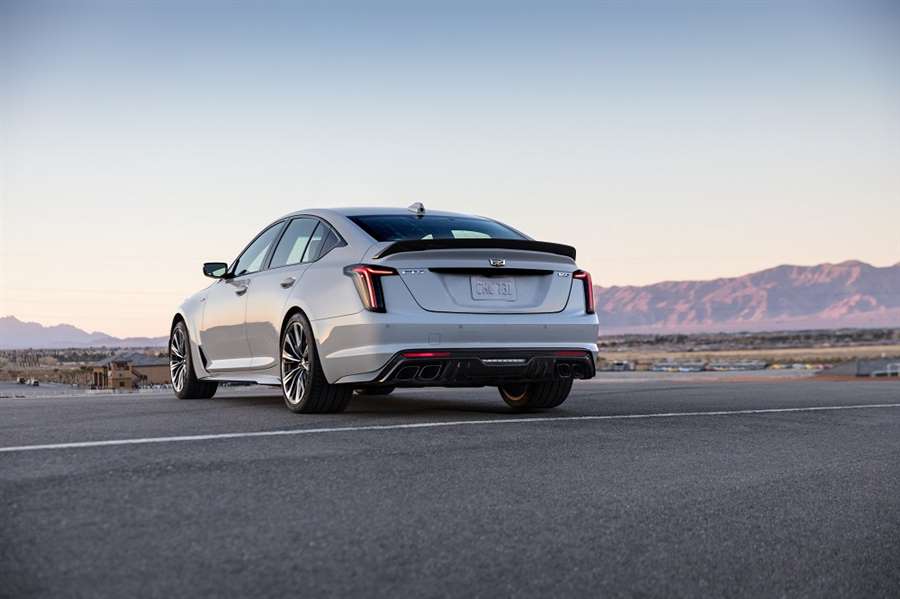
Let's start with the best part, and he is hiding under the hood. There is a new generation of "eights" under the code number LS, and this time the volume is 6.2 liters. Paired with a compressor, this unit not only develops 668 "heads" but also a maximum of 893 Nm of torque. It is also the fastest Cadillac to ever get off the production line with acceleration from zero to 100 km / h in 3.7 seconds and a top speed of around 200 mph (320 km / h).
What is even more impressive is the fact that General Motors has found a way to provide a manual transmission that would withstand such torque, and in this case it has six gears. However, Cadillac notes that if owners want to get the aforementioned performance, they will have to choose a ten-speed automatic transmission, as the manual one will be slightly slower.
Similar to the smaller CT4-V, this Blackwing also brings 19-inch wheels, Brembo brakes, sports tires and a number of suspension modifications. American cars have a reputation for being fast only in direction, but the CT5-V could break the record at the Nurburgring, which is in force among four-door production sedans.
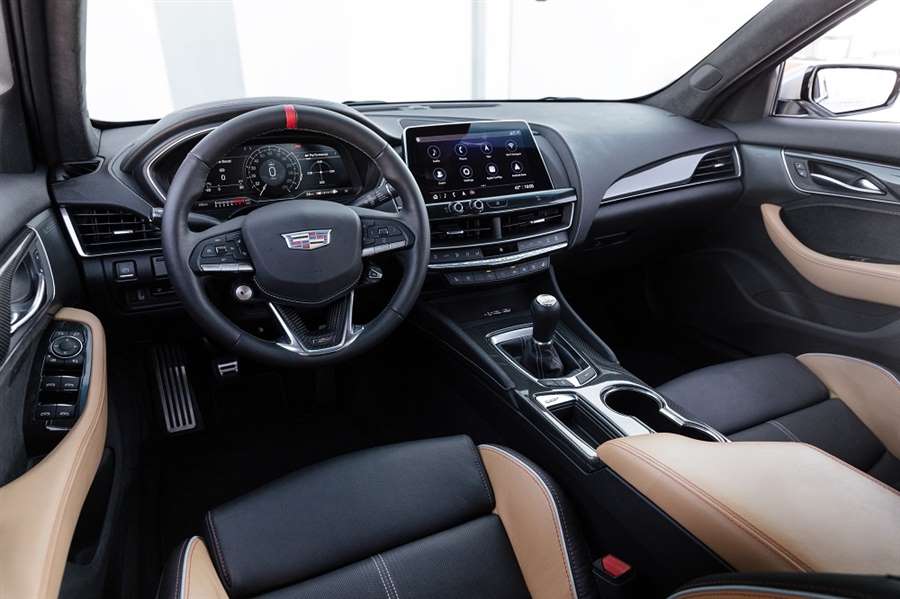
Also, we must mention that the Cadillac did not overdo it with the design changes, and this Blackwing looks like what the Americans call a "sleeper", that is, a "sleepy" car. This term is used for four-wheelers where attention is paid to mechanics, while in style they look like any other car on the track or on the road, whatever.
With the exception of the rims, four exhaust manifolds and a few badges, the Blackwing won’t set it apart too much from any other CT5 model. The starting price of 84,990 smallest greenbacks is over 20,000 "greenbacks" more modest than the one demanded by German competition such as the BMW M5 and the Mercedes-AMG E63.
Needless to say, BMW and Mercedes are significantly faster on the road as the Cadillac’s mass of over two tons is by no means in its favor.
At the end of the day, let’s enjoy the end of an era that we will all surely miss one day. The future electric Cadillacs will certainly be more powerful and faster, but we will, one hundred percent know, miss the smell of gasoline and the thunder of V8 engines…
2021 Lexus RC350 F Sport First Drive: Coupe'd Up Like the Rest Of Us
This luxurious two-door is showing its age, but it’s still a rewarding car for people who love to drive.
The Lexus RC coupe, like the recently updated-for-2021 Lexus IS sedan, has been around for some time, first going on sale in 2015 and receiving a major face-lift in 2018. It doesn't have too many competitors. Sporty luxury coupes aren't nearly as popular as upscale SUVs these days, leaving the Lexus battling three primary competitors: the BMW 2 Series, the Infiniti Q60, and the Audi A5. Within that bunch, The RC is the only one to offer a naturally aspirated engine, and as a result, it falls somewhat awkwardly between rivals that use turbocharged four-cylinder powerplants and those with mightier turbocharged V-6 engines.
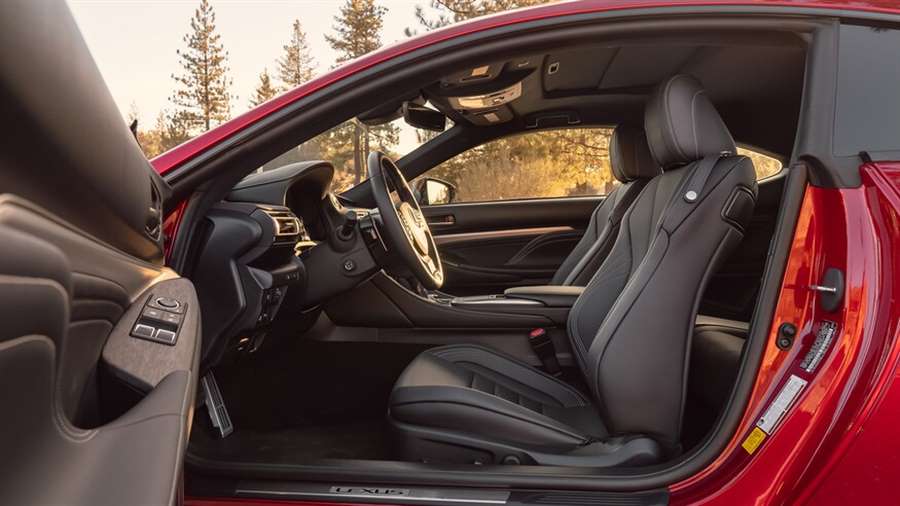
We got our hands on an example of the midrange 2021 Lexus RC350 F Sport, which sits above the entry-level RC300 and below the muscular RC F. Over the span of two weeks, we attacked canyon roads, climbed mountains, and took on some heady freeway mileage to see if the RC has the goods to impress as it nears its twilight years.
Natural Aspirator
It packs a 311-hp V-6 engine that produces 280 lb-ft of torque. An eight-speed automatic transmission handles gear changes and sends power to the rear wheels in this guise, though an all-wheel-drive variant is available. The engine sounds great, and shifts come quickly, crisply, and accurately. It's one of the rare naturally aspirated powerplants still on sale; revving it out for all its worth is enjoyable, and doing so is met with a great exhaust note.
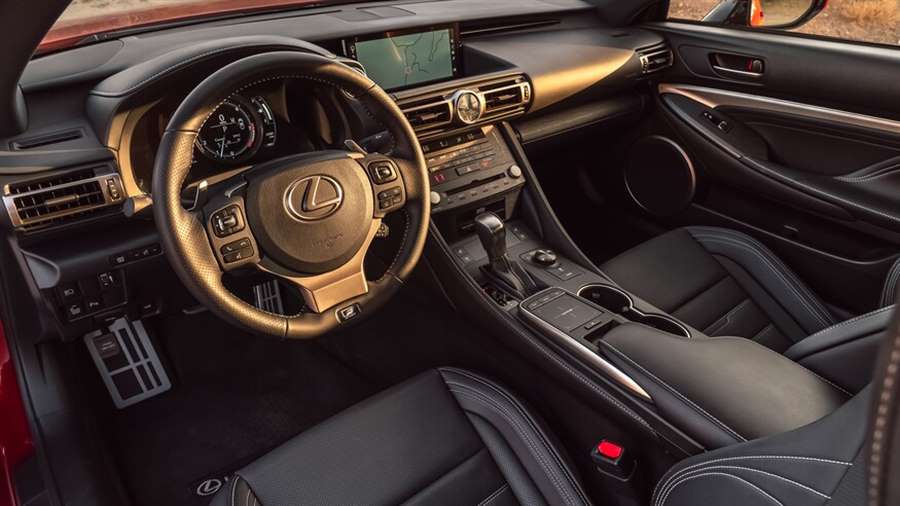
Maybe I've gotten used to the spindle grille, but the Lexus RC still looks sharp to me all these years later, even if I'm in the minority. Our car came with Metallic Infrared paint, a premium color for an additional $595, accented with additional orange F Sport brake calipers ($300). There's very little chrome on the exterior, just one strip on each side mirror, which should help prevent this car from looking dated for years to come. Otherwise, dark gunmetal gray trims the rest of the vehicle, endowing it with a mature, serious look. The power moonroof, which also helps brighten up the black and gray cabin, added another $1,100 to the total sum.
On the open road, the RC350 F Sport serves as a GT-lite. It's not nearly as powerful as its big brother, the gorgeous and capable LC500, but its adaptive F Sport suspension does a great job soaking up road imperfection in the Normal drive mode and stiffens up for better body control when set to Sport S or Sport S+ mode. Although the throttle and brake pedals provide direct and predictable feel, the V-6 doesn't quite provide enough grunt to match its sporty aesthetic.
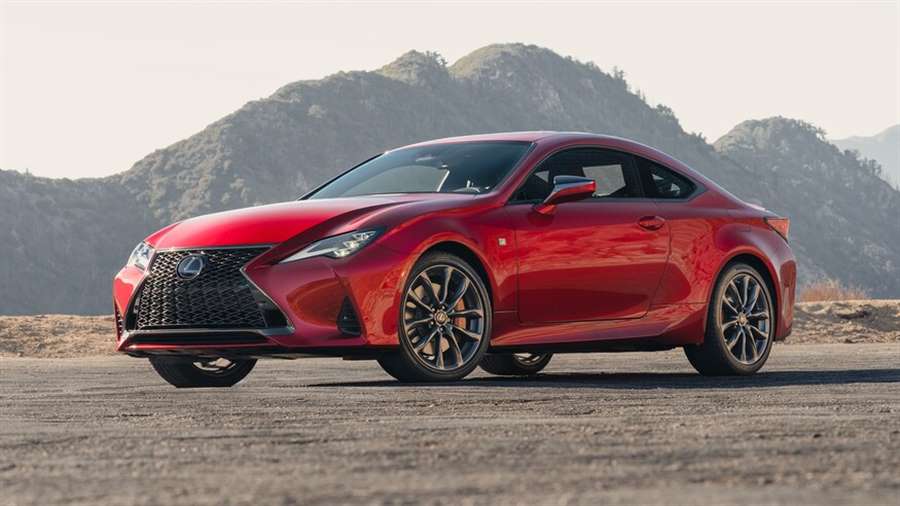
In addition to the RC not being quite as quick as it feels like it should be, fuel economy isn't too impressive, either. The EPA rates the RC350 F Sport at 20/28 mpg city/highway. Drivers who like to zip off of the line can expect those numbers to dip to old-school muscle-car digits if they aren't careful. This is partially because this Lexus tips the scales just shy of two tons. So even though it's nimble, its heftiness hurts at the pump and the dragstrip.
This prevailing sense of predictability prevents the RC350 F Sport from offering true excitement. The engine, though it provides decent power at the top end of the rev range, doesn't quite have the torque to make launches or on-ramp runs exhilarating. At best, it brought a smirk to my face as I navigated tricky roads with ease and evoked some utterances of surprise that a midrange Lexus coupe handled so well without any drama whatsoever. It simply complies with the driver's wishes. For some folks, that's all they want in a car, and I get the appeal of that characteristic.
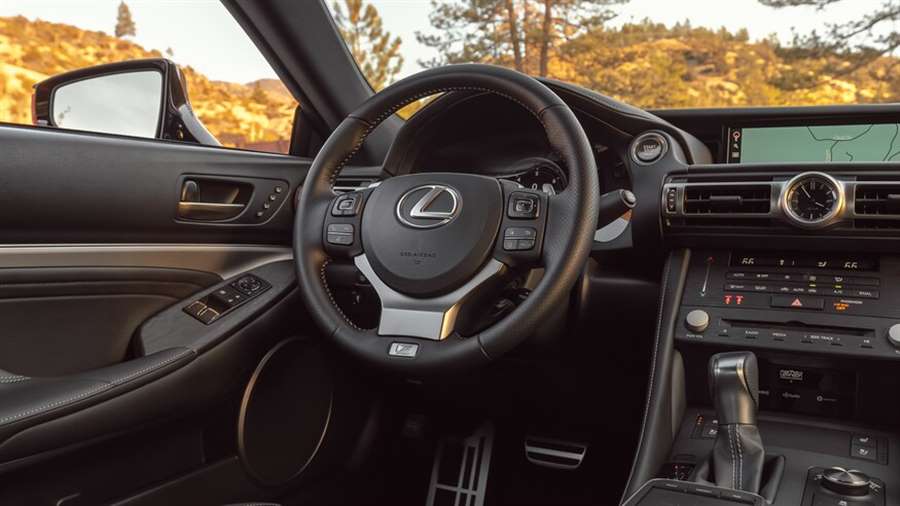
F-Ing Well Equipped
Our car came equipped with a smattering of options, most notably the Lexus Dynamic Handling package with dynamic rear steering and variable-gear ratio steering ($1,900), which helped the coupe handle with impressive poise on winding roads. The steering feels direct, gives good feedback, and is tuned well for navigating technical routes. A Torsen limited-slip differential ($390) also helped up our test car's handling. It even rode on summer tires, which had plenty of grip for brisk jaunts on our favorite roads.
Interior amenities are typical Lexus: a somewhat anachronistic user interface (saved in part by Apple CarPlay/Android Auto) and excellent materials and build quality. The leather seats were comfortable on the long haul and supportive when I took advantage of the car's great handling characteristics on fun roads. The transmission tunnel is pretty large and eats into the cockpit space, and there aren't a ton of storage cubbies, but then again, this is a compact coupe, not a bulbous crossover, so this detraction might not be a penalty for buyers expecting a cocoon-like cockpit. Trunk space is plentiful for a pair of travelers who don't like to travel light.
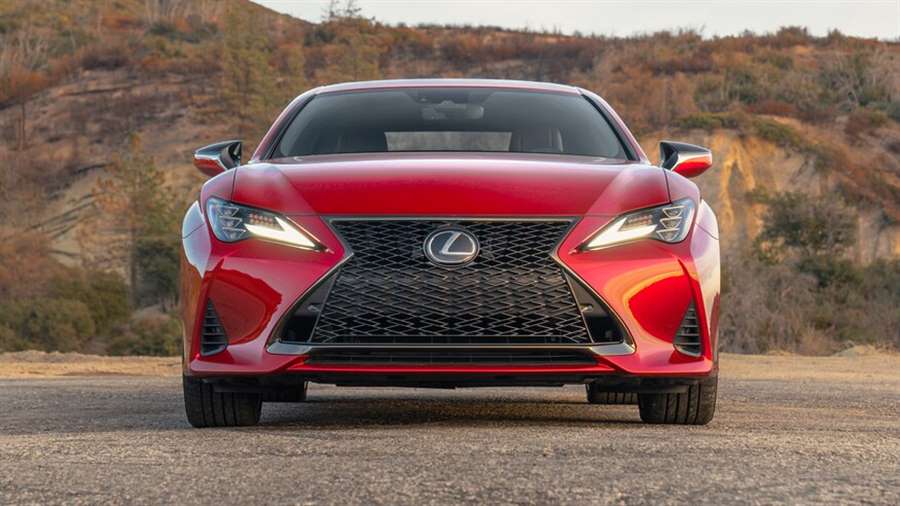
Good Deal Or No Deal
Other cool features on our test car include the triple-beam LED headlights ($1,160), a package that bundles in-car navigation and the Mark Levinson audio package ($2,725), and the Intuitive Parking Assist sensor package ($500). In all, our model we tested, almost $10,000 more than the $50,645 starting price for the RWD RC350 F Sport test car topped $60,000. Its performance lies in between the trim levels and engines of its competitors, but its starting price is more closely aligned with higher performance cars such as the Audi S5, which starts at $53,545 and has a more powerful turbocharged V-6 engine.
The RC350 F Sport is fun to drive without offering paradigm-shifting acceleration or speed. It's comfortable both physically and in the manner it performs. Those looking for more excitement should opt for the full-hog RC F. However, for dependable, luxurious transportation that can still provide driving joy when there are fun roads to explore, the RC350 F Sport is worth considering.
2020 Lexus RC350 F Sport Pros
Crisp, striking bodywork
Well-made and luxurious interior
Performance upgrades that add impressive capability
2020 Lexus RC350 F Sport Cons
Not as quick as we'd like
Poor fuel economy
Antiquated infotainment system and subpar track pad
Source: motortrend.com

